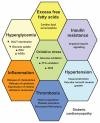Diabetic cardiomyopathy: from the pathophysiology of the cardiac myocytes to current diagnosis and management strategies
- PMID: 21057575
- PMCID: PMC2964943
- DOI: 10.2147/VHRM.S11681
Diabetic cardiomyopathy: from the pathophysiology of the cardiac myocytes to current diagnosis and management strategies
Abstract
Diabetic cardiomyopathy (DCM), although a distinct clinical entity, is also a part of the diabetic atherosclerosis process. It may be independent of the coexistence of ischemic heart disease, hypertension, or other macrovascular complications. Its pathological substrate is characterized by the presence of myocardial damage, reactive hypertrophy, and intermediary fibrosis, structural and functional changes of the small coronary vessels, disturbance of the management of the metabolic cardiovascular load, and cardiac autonomic neuropathy. These alterations make the diabetic heart susceptible to ischemia and less able to recover from an ischemic attack. Arterial hypertension frequently coexists with and exacerbates cardiac functioning, leading to the premature appearance of heart failure. Classical and newer echocardiographic methods are available for early diagnosis. Currently, there is no specific treatment for DCM; targeting its pathophysiological substrate by effective risk management protects the myocardium from further damage and has a recognized primary role in its prevention. Its pathophysiological substrate is also the objective for the new therapies and alternative remedies.
Keywords: atherosclerosis; cardiac autonomic neuropathy; cardiovascular disease; echocardiography; treatment strategies.
Figures

Similar articles
-
[Diabetic cardiomyopathy].Arq Bras Endocrinol Metabol. 2007 Mar;51(2):160-7. doi: 10.1590/s0004-27302007000200004. Arq Bras Endocrinol Metabol. 2007. PMID: 17505622 Review. Portuguese.
-
Diabetic myocardial disease: pathophysiology, early diagnosis and therapeutic options.J Diabetes Complications. 2009 Jul-Aug;23(4):273-82. doi: 10.1016/j.jdiacomp.2007.12.005. Epub 2008 Apr 16. J Diabetes Complications. 2009. PMID: 18413201 Review.
-
Diabetic cardiomyopathy--to take a long story serious.Herz. 2010 May;35(3):161-8. doi: 10.1007/s00059-010-3336-0. Herz. 2010. PMID: 20467928
-
Diagnostic approaches for diabetic cardiomyopathy and myocardial fibrosis.J Mol Cell Cardiol. 2010 Mar;48(3):524-9. doi: 10.1016/j.yjmcc.2009.06.021. Epub 2009 Jul 9. J Mol Cell Cardiol. 2010. PMID: 19595694 Free PMC article. Review.
-
[Diabetic cardiomyopathy: old disease or new entity?].Srp Arh Celok Lek. 2007 Sep-Oct;135(9-10):576-82. Srp Arh Celok Lek. 2007. PMID: 18088046 Review. Serbian.
Cited by
-
Astragaloside IV alleviates myocardial damage induced by type 2 diabetes via improving energy metabolism.Mol Med Rep. 2019 Nov;20(5):4612-4622. doi: 10.3892/mmr.2019.10716. Epub 2019 Oct 1. Mol Med Rep. 2019. PMID: 31702040 Free PMC article.
-
Diabetic cardiomyopathy: Pathophysiology, diagnostic evaluation and management.World J Diabetes. 2013 Oct 15;4(5):177-89. doi: 10.4239/wjd.v4.i5.177. World J Diabetes. 2013. PMID: 24147202 Free PMC article. Review.
-
Association of Serum Adiponectin with Intima Media Thickness of Dorsalis Pedis Artery and Macroangiopathy in Type 2 Diabetes.J Diabetes Res. 2020 Jan 3;2020:4739271. doi: 10.1155/2020/4739271. eCollection 2020. J Diabetes Res. 2020. PMID: 31998806 Free PMC article.
-
Extracellular Vesicles as Protagonists of Diabetic Cardiovascular Pathology.Front Cardiovasc Med. 2017 Nov 9;4:71. doi: 10.3389/fcvm.2017.00071. eCollection 2017. Front Cardiovasc Med. 2017. PMID: 29209616 Free PMC article. Review.
-
Present Insights on Cardiomyopathy in Diabetic Patients.Curr Diabetes Rev. 2016;12(4):384-395. doi: 10.2174/1573399812666150914120529. Curr Diabetes Rev. 2016. PMID: 26364799 Free PMC article. Review.
References
-
- Amos AF, McCarty DJ, Zimmet P. The rising global burden of diabetes and its complications: estimates and projections to the year 2010. Diabet Med. 1997;14(Suppl 1):S1–S85. - PubMed
-
- Fisher BM, Gillen G, Lindop GB, Dargie HJ, Frier BM. Cardiac function and coronary arteriography in asymptomatic type-1 (insulin-dependent) diabetic patients: evidence for a specif ic diabetic heart disease. Diabetologia. 1986;29:706–712. - PubMed
-
- Kannel WB, Hjortland M, Castelli WP. Role of diabetes in congestive heart failure: the Framingham Study. Am J Cardiol. 1976;34:29–34. - PubMed
-
- Kannel WB, McGee DL. Diabetes and cardiovascular disease: the Framingham Study. JAMA. 1979;241:2035–2038. - PubMed
-
- Rubler S, Dlugash J, Yuceoglu YZ, Kumral T, Branwood AW, Grishman A. New type of cardiomyopathy associated with diabetic glomerulosclerosis. Am J Cardiol. 1972;30:595–602. - PubMed

